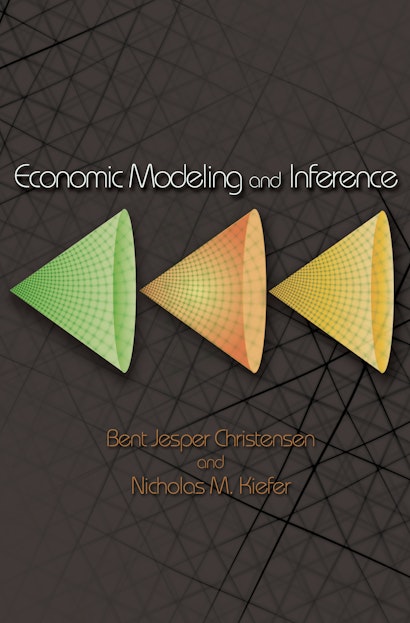Economic Modeling and Inference takes econometrics to a new level by demonstrating how to combine modern economic theory with the latest statistical inference methods to get the most out of economic data. This graduate-level textbook draws applications from both microeconomics and macroeconomics, paying special attention to financial and labor economics, with an emphasis throughout on what observations can tell us about stochastic dynamic models of rational optimizing behavior and equilibrium. Bent Jesper Christensen and Nicholas Kiefer show how parameters often thought estimable in applications are not identified even in simple dynamic programming models, and they investigate the roles of extensions, including measurement error, imperfect control, and random utility shocks for inference. When all implications of optimization and equilibrium are imposed in the empirical procedures, the resulting estimation problems are often nonstandard, with the estimators exhibiting nonregular asymptotic behavior such as short-ranked covariance, superconsistency, and non-Gaussianity. Christensen and Kiefer explore these properties in detail, covering areas including job search models of the labor market, asset pricing, option pricing, marketing, and retirement planning. Ideal for researchers and practitioners as well as students, Economic Modeling and Inference uses real-world data to illustrate how to derive the best results using a combination of theory and cutting-edge econometric techniques.
- Covers identification and estimation of dynamic programming models
- Treats sources of error—measurement error, random utility, and imperfect control
- Features financial applications including asset pricing, option pricing, and optimal hedging
- Describes labor applications including job search, equilibrium search, and retirement
- Illustrates the wide applicability of the approach using micro, macro, and marketing examples
"Economic Modeling and Inference gives an excellent overview of dynamic modeling techniques in economics and fills an important gap among current textbooks. [It] is an excellent book, especially for graduate students in economics. . . . [I]t is also a must for economists who need a refresher course in dynamic modeling . . . [and] should also be on the bookshelf of practicing researchers interested in expanding the number of models used in their work."—Journal of the American Statistical Association
"Economic Modeling and Inference offers a technically sophisticated grounding in the structural approach to analyzing data. The book does an excellent job of illustrating the wide range of questions that the empirical dynamic programming approach can tackle by explicitly bridging economic theory and econometrics. . . . Books such as these will undoubtedly help the structural paradigm more successfully compete in the market for applied econometric methodologies."—Robert M. Sauer, Journal of Economic Literature
"Overall, the book is well structured and will be useful for many different purposes, ranging from a main text for a PhD-level course to practical guidance for researchers who do empirical work based on dynamic programming models."—Dong-Hyuk Kim, Economic Record
"Christensen and Kiefer's excellent book shows how careful dynamic theory and econometrics go hand in hand, opening up new vistas in the areas of search theory, finance, and macroeconomics."—Tom Sargent, New York University and the Hoover Institution
"There is no other book that mixes dynamic economic theory, statistical inference, and real quantitative applications like this one. Christensen and Kiefer will challenge the top tier of students and take them to the research frontier."—Robert Lucas, University of Chicago
"Dynamic programming is an organizing framework that has enabled economists to integrate economic theory with empirical analysis. Few textbooks reflect the integrated nature of contemporary research, but Christensen and Kiefer reveal the power of the dynamic programming approach in a wide variety of applications from job search to portfolio choice. Their new book will be invaluable to students who wish to participate in this exciting enterprise."—John Y. Campbell, Harvard University
"The authors do a splendid job of showing how to use stochastic dynamic optimization techniques to generate the implied distributions of observables needed for estimation. There are many interesting and useful examples included in the book, ranging from applications of the theory of job search to those of asset pricing theory. This book should be a reference for anyone interested in using dynamic economic models to make inferences about the world we observe."—Dale Mortensen, Aarhus University, Denmark, and Northwestern University
"An extremely ambitious and thought-provoking book, one that combines state-of-the-art economic theory with sophisticated econometric techniques. The dynamic programming framework brings together important results and recent developments in a unique, unified way. The book is sure to inspire many PhD students and empirically oriented researchers for years to come."—Tim Bollerslev, Duke University
"I have been looking for a book like this for quite a while. Economic Modeling and Inference is written for those who want to do applied work and actually apply this to real-life data or run simulations. This much-needed book fills a void. It is certainly a significant contribution to the field."—Yaw Nyarko, New York University
"Economic Modeling and Inference blends economic theory and statistical inference in a seamless fashion. Every dynamic decision model is discussed with an eye for it to be fit with economic data. Every econometric inference tool is developed for the purpose of testing economic decision models. This book is long overdue. It will influence and benefit young economists for generations to come."—Mark Y. An, Fannie Mae

